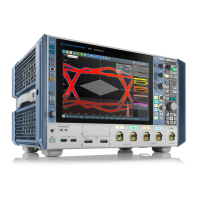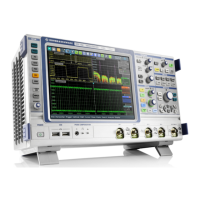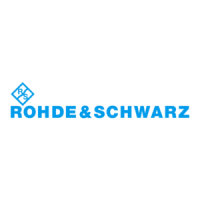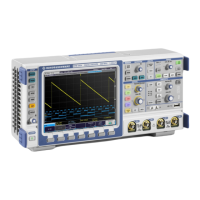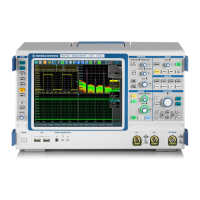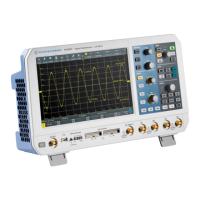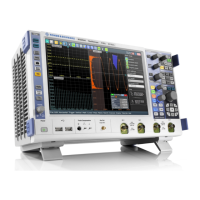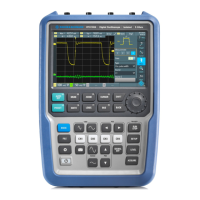Pulse source and TDR/TDT analysis (option R&S RTP-B7/K130)
R&S
®
RTP
988User Manual 1337.9952.02 ─ 12
Clock mode
Sets the dependency of the pulse clock on the instrument's reference clock. The
appropriate clock mode depends on the measurement application.
"Free running"
The clock of the pulse source is independent. Deviations of the sys-
tem do not affect the pulse clock, and deterministic conditions are
avoided.
If the waveform aquisition is set to "Average", the "free running" clock
mode can improve the measurement result. Internal spurious signals
of the instrument are reduced by averaging, because they are not
coherent to the pulse source signal.
See also: "Wfm Arithmetic" on page 152.
"Locked"
The pulse source is locked to the reference clock of the instrument.
Remote command:
PSRC:CLOCkmode on page 2242
Preset
Resets the pulse source to the default state. Pulse source settings are not are not
affected by an instrument preset. They are also not stored in the user-defined preset.
Remote command:
PSRC:RST on page 2242
16.2 TDR/TDT analysis (option R&S RTP-K130)
The option R&S RTP-K130 provides analysis of time domain reflectometry (TDR) and
time domain transmission (TDT) to verify high-speed digital designs. Using the results
of the TDR/TDT calibration, the instrument removes the effects of the cables (deem-
bedding), and measures the DUT.
Typical use cases are:
●
Locate faults in a circuit
●
Measure impedance
●
Measure step response of a DUT
You can use the TDR/TDT option for single-ended and differential measurements.
16.2.1 About TDR/TDT measurements
Using TDR/TDT measurements, you can analyze the reflections and transmission
characteristics of a DUT. With TDR, it is possible to determine the type, magnitude and
location of a fault. TDT delivers information on stability, losses and bandwidth of the
DUT.
The signal source is the pulse source, and the oscilloscope measures the reflected and
transmitted signals.
TDR/TDT analysis (option R&S
RTP-K130)

